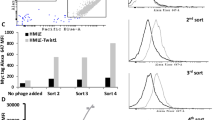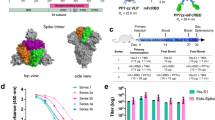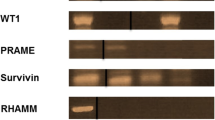Abstract
We have previously used a subtractive immunization (SI) approach to generate monoclonal antibodies (mAbs) against proteins preferentially expressed by the highly metastatic human epidermoid carcinoma cell line, M+HEp3. Here we report the immunopurification, identification and characterization of SIMA135/CDCP1 (subtractive immunization M+HEp3 associated 135 kDa protein/CUB domain containing protein 1) using one of these mAbs designated 41-2. Protein expression levels of SIMA135/CDCP1 correlated with the metastatic ability of variant HEp3 cell lines. Protein sequence analysis predicted a cell surface location and type I orientation of SIMA135/CDCP1, which was confirmed directly by immunocytochemistry. Analysis of deglycosylated cell lysates indicated that up to 40 kDa of the apparent molecular weight of SIMA135/CDCP1 is because of N-glycosylation. Western blot analysis using a antiphosphotyrosine antibody demonstrated that SIMA135/CDCP1 from HEp3 cells is tyrosine phosphorylated. Selective inhibitor studies indicated that an Src kinase family member is involved in the tyrosine phosphorylation of the protein. In addition to high expression in M+HEp3 cells, the SIMA135/CDCP1 protein is expressed to varying levels in 13 other human tumor cell lines, manifesting only a weak correlation with the reported metastatic ability of these tumor cell lines. The protein is not detected in normal human fibroblasts and endothelial cells. Northern blot analysis indicated that SIMA135/CDCP1 mRNA has a restricted expression pattern in normal human tissues with highest levels of expression in skeletal muscle and colon. Immunohistochemical analysis indicated apical and basal plasma membrane expression of SIMA135/CDCP1 in epithelial cells in normal colon. In colon tumor, SIMA135/CDCP1 expression appeared dysregulated showing extensive cell surface as well as cytoplasmic expression. Consistent with in vitro shedding experiments on HEp3 cells, SIMA135/CDCP1 was also detected within the lumen of normal and cancerous colon crypts, suggesting that protein shedding may occur in vivo. Thus, specific immunodetection followed by proteomic analysis allows for the identification and partial characterization of a heretofore uncharacterized human cell surface antigen.
This is a preview of subscription content, access via your institution
Access options
Subscribe to this journal
Receive 50 print issues and online access
$259.00 per year
only $5.18 per issue
Buy this article
- Purchase on Springer Link
- Instant access to full article PDF
Prices may be subject to local taxes which are calculated during checkout






Similar content being viewed by others
References
Adham IM, Klemm U, Maier WM and Engel W . (1990). Hum. Genet., 84, 125–128.
Bajorath J . (2000). Proteins, 39, 103–111.
Blom N, Gammeltoft S and Brunak S . (1999). J. Mol. Biol., 294, 1351–1362.
Bork P and Beckmann G . (1993). J. Mol. Biol., 231, 539–545.
Briner TJ, Kuo MC, Keating KM, Rogers BL and Greenstein JL . (1993). Proc. Natl. Acad. Sci. USA, 90, 7608–7612.
Brooks PC, Lin JM, French DL and Quigley JP . (1993). J. Cell Biol., 122, 1351–1359.
Chen CB and Wallis R . (2001). J. Biol. Chem., 276, 25894–25902.
Falquet L, Pagni M, Bucher P, Hulo N, Sigrist CJ, Hofmann K and Bairoch A . (2002). Nucleic Acids Res., 30, 235–238.
Goebeler M, Kaufmann D, Brocker EB and Klein CE . (1996). J. Cell Sci., 109 (Part 7), 1957–1964.
Gorelik E, Galili U and Raz A . (2001). Cancer Metast. Rev., 20, 245–277.
Grogan MJ, Pratt MR, Marcaurelle LA and Bertozzi CR . (2002). Annu. Rev. Biochem., 71, 593–634.
Hanke JH, Gardner JP, Dow RL, Changelian PS, Brissette WH, Weringer EJ, Pollok BA and Connelly PA . (1996). J. Biol. Chem., 271, 695–701.
Hansen SG, Grosenbach DW and Hruby DE . (1999). Virology, 254, 124–137.
Hartmann E, Rapoport TA and Lodish HF . (1989). Proc. Natl. Acad. Sci. USA, 86, 5786–5790.
Hooper JD, Clements JA, Quigley JP and Antalis TM . (2001). J. Biol. Chem., 276, 857–860.
King SW and Morrow Jr KJ, (1988). Biotechniques, 6, 856–861.
Martin GS . (2001). Nat. Rev. Mol. Cell Biol., 2, 467–475.
Maruo Y, Gochi A, Kaihara A, Shimamura H, Yamada T, Tanaka N and Orita K . (2002). Int. J. Cancer, 100, 486–490.
Matthew WD and Patterson PH . (1983). Cold Spring Harb. Symp. Quant. Biol., 48 (Part 2), 625–631.
Mayer BJ . (2001). J. Cell Sci., 114, 1253–1263.
Nakai K and Kanehisa M . (1992). Genomics, 14, 897–911.
Nielsen-Preiss SM and Quigley JP . (1993). J. Cell Biochem., 51, 219–235.
Ossowski L and Reich E . (1983). Cell, 33, 323–333.
Pawson T . (1995). Nature, 373, 573–580.
Resh MD . (1994) Cell, 76, 411–413.
Riggott MJ and Matthew WD . (1996). J. Neurosci. Methods, 68, 235–245.
Rye PD and McGuckin MA . (2001). Tumour Biol., 22, 269–272.
Scherl-Mostageer M, Sommergruber W, Abseher R, Hauptmann R, Ambros P and Schweifer N . (2001). Oncogene, 20, 4402–4408.
Schultz J, Milpetz F, Bork P and Ponting CP . (1998). Proc. Natl. Acad. Sci. USA, 95, 5857–5864.
Sieron AL, Tretiakova A, Jameson BA, Segall ML, Lund-Katz S, Khan MT, Li S and Stocker W . (2000). Biochemistry, 39, 3231–3239.
Sleister HM and Rao AG . (2002). J. Immunol. Methods, 261, 213–220.
Songyang Z, Shoelson SE, Chaudhuri M, Gish G, Pawson T, Haser WG, King F, Roberts T, Ratnofsky S, Lechleider RJ, Neel BG, Birge RB, Fajardo JE, Chou MM, Hanafusa H, Schaffhausen B and Cantley LC . (1993). Cell, 72, 767–778.
Soos G, Jones RF, Haas GP and Wang CY . (1997). Anticancer Res., 17, 4253–4258.
Stocker JW and Nossal GJ . (1976). Contemp. Top. Immunobiol., 5, 191–210.
Testa JE . (1992). Cancer Res., 52, 5597–5603.
Testa JE, Brooks PC, Lin JM and Quigley JP . (1999). Cancer Res., 59, 3812–3820.
Wajih N, Walter J and Sane DC . (2002). Circ. Res., 90, 46–52.
Williams CV, Stechmann CL and McLoon SC . (1992). Biotechniques, 12, 842–847.
Yammani RR, Seetharam S and Seetharam B . (2001). J. Biol. Chem., 276, 44777–44784.
Zhang W, Trible RP and Samelson LE . (1998). Immunity, 9, 239–246.
Acknowledgements
We thank Rebecca Mellor, Giano Panzarella, Sarah Lustig and Jeanine Kleeman for expert technical assistance and Dr Linda Wasserman (Department of Pathology, University of California, San Diego, CA, USA) for archival colon tissue samples. This work was supported by National Institutes of Health Grants CA65660, HL31950 (JPQ), and Training Grants T32 HL07695 (AZ) and T32 HL07195 (GFC), and a National Health and Medical Research Council of Australia CJ Martin/RG Menzies Fellowship (JDH).
Author information
Authors and Affiliations
Corresponding author
Rights and permissions
About this article
Cite this article
Hooper, J., Zijlstra, A., Aimes, R. et al. Subtractive immunization using highly metastatic human tumor cells identifies SIMA135/CDCP1, a 135 kDa cell surface phosphorylated glycoprotein antigen. Oncogene 22, 1783–1794 (2003). https://doi.org/10.1038/sj.onc.1206220
Received:
Revised:
Accepted:
Published:
Issue Date:
DOI: https://doi.org/10.1038/sj.onc.1206220
Keywords
This article is cited by
-
CDCP1 expression is frequently increased in aggressive urothelial carcinoma and promotes urothelial tumor progression
Scientific Reports (2023)
-
An oncogenic viral interferon regulatory factor upregulates CUB domain-containing protein 1 to promote angiogenesis by hijacking transcription factor lymphoid enhancer-binding factor 1 and metastasis suppressor CD82
Cell Death & Differentiation (2020)
-
Identification of CD318 (CDCP1) as novel prognostic marker in AML
Annals of Hematology (2020)
-
CDCP1 enhances Wnt signaling in colorectal cancer promoting nuclear localization of β-catenin and E-cadherin
Oncogene (2020)
-
Extracellular vesicles for liquid biopsy in prostate cancer: where are we and where are we headed?
Prostate Cancer and Prostatic Diseases (2017)



